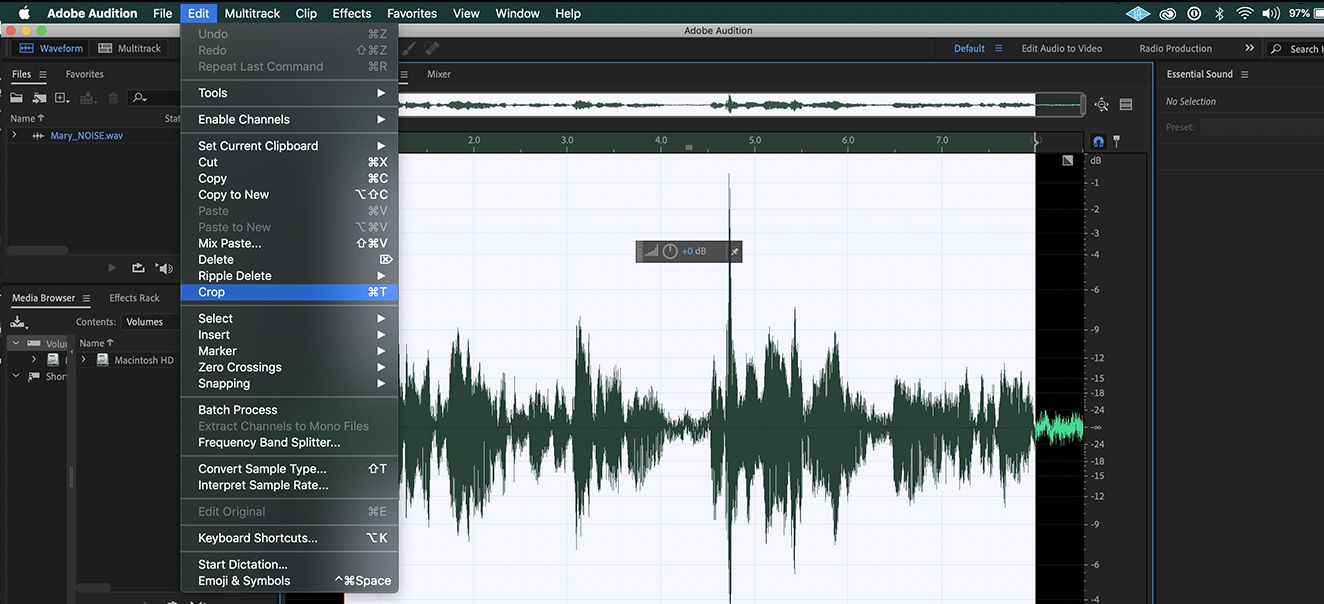

- MAC SHORTCUTS FOR ADOBE AUDITION HOW TO
- MAC SHORTCUTS FOR ADOBE AUDITION MAC OS X
- MAC SHORTCUTS FOR ADOBE AUDITION PRO
- MAC SHORTCUTS FOR ADOBE AUDITION TRIAL
- MAC SHORTCUTS FOR ADOBE AUDITION PROFESSIONAL
( Click here for a list.) I’m releasing another session on mixing and effects shortly.įor this article, though, I want to share some quick tips on working with Audition There are some very cool features here that you might not find right away.
MAC SHORTCUTS FOR ADOBE AUDITION HOW TO
Out of that has evolved a series of video training on how to record and edit audio using Audition. A couple of months ago, I finally decided to take a closer look.
MAC SHORTCUTS FOR ADOBE AUDITION PROFESSIONAL
However, Adobe Audition, while new to the Mac, is very well-established in the broadcast industry and professional audio on Windows. As every editor knows, making the transition from one major editing application to another is fraught with all kinds of stress and as more of my work involves audio than video, my stress level was higher than usual.
MAC SHORTCUTS FOR ADOBE AUDITION PRO
(And for the younger set, here’s a description of a 78 record…)Īnyway, lest I wax too nostalgic, my audio career evolved from analog into ProTools, from ProTools to Soundtrack Pro, and from Soundtrack Pro to… ?Īs Apple was phasing out Soundtrack Pro, Adobe announced the CS5.5 release of Adobe Audition which brought this audio recording and editing software to the Mac. My career in media began so long ago that, well, let’s just say that faders were large rotating knobs and not sliders, and we could still buy records that spun at 78 rpm.


Already have an account? Login HERE.Adobe Audition is an audio editing application that I am increasingly impressed with especially with the death of Soundtrack Pro.
MAC SHORTCUTS FOR ADOBE AUDITION TRIAL
Want to learn more about AudioAcrobat? Go ahead, give it a try yourself by signing up for a 30 day Free Trial or join one of our FREE Training Classes without signing up for squat. Were you able to follow-along with the process above? Did you get stopped somewhere along the way?Ĭomment below and connect with us for daily updates! Click OK on the Export File pop-up window and watch as Adobe Audition quickly works to export your brand-new MP3 file! Here, the Export File pop-up window will appear:Ĭhoosing the Format drop-down menu will provide the following options:Īs seen in the above image, we’ll want to select the MP3 option. Using the keyboard shortcut ⇧+ ⌘+E (Shift+Command+E) or choosing File > Export > File, we can begin the process of exporting our file in the format of our choice, which in today’s exercise will be in the MP3 format. We’re good so far, yeah? Sweet! We’re already more than halfway through today’s exercise. Double-click the WAV file or click once and choose Open to bring the file into Adobe Audition.Īt this point, you should see the waveform of your WAV file appear with bright green peaks atop of a black background with a square grid pattern, like this: Here, you can either use the keyboard shortcut ⌘+O (Command+O) or choose File > Open from the menus at the top left of your application window to bring up the familiar pop-up window which will allow you to select the WAV file we’ll be converting to the MP3 format. Don’t worry, as this will fill in momentarily. With the Adobe Audition application open, there will be lots of empty space. If so, simply click the icon in your dock to launch Adobe Audition. Now I’m going to click the Adobe Audition folder and click again on the Adobe Audition application icon.Īlternately, you could open Finder and navigate to Applications > Adobe Audition CSx.x > Adobe Audition.įurthermore, if you are a regular Adobe Audition user, you may have already chosen to keep the software in your dock for easy access.
MAC SHORTCUTS FOR ADOBE AUDITION MAC OS X
For sake of keeping things simple, I like to click the Applications folder in the dock of my Mac OS X installation, where all of the applications installed on the computer you’re using will appear.įollow me so far? Excellent. There are several ways to accomplish this first step. I won’t be getting super technical, nor will I be exploring any advanced features, although this software is packed with them! Which brings us to today’s post, where I have created a short, easy-to-use tutorial on using Adobe Audition to open, convert and save WAV files in the MP3 format. Moving forward in time to the early-mid 2000’s, Cool Edit Pro (v2.1) was purchased by Adobe and became known by today’s standards as Adobe Audition. If we were to take a trip down memory lane to a decade where audio editing software was just a budding concept, there was a program called Cool Edit, which later evolved to Cool Edit Pro. Today I’ll be sharing a similar process using a different piece of software that I found in the Applications folder on my MacBook Pro. Some of the most popular blog posts here on the AudioAcrobat Weblog were written on converting WAV to MP3 using Audacity for both Mac and PC.


 0 kommentar(er)
0 kommentar(er)
